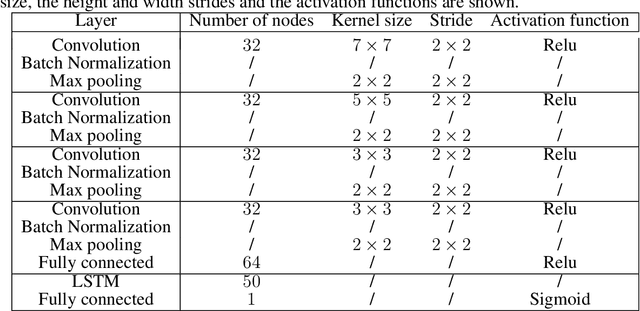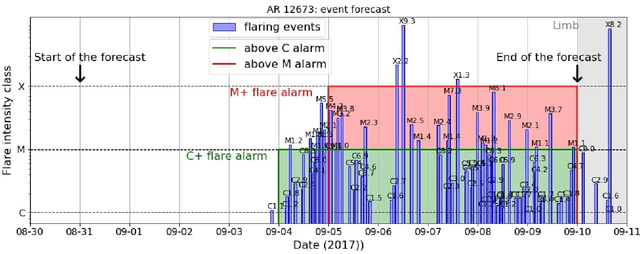Francesco Marchetti
Feature Understanding and Sparsity Enhancement via 2-Layered kernel machines (2L-FUSE)
Sep 09, 2025Abstract:We propose a novel sparsity enhancement strategy for regression tasks, based on learning a data-adaptive kernel metric, i.e., a shape matrix, through 2-Layered kernel machines. The resulting shape matrix, which defines a Mahalanobis-type deformation of the input space, is then factorized via an eigen-decomposition, allowing us to identify the most informative directions in the space of features. This data-driven approach provides a flexible, interpretable and accurate feature reduction scheme. Numerical experiments on synthetic and applications to real datasets of geomagnetic storms demonstrate that our approach achieves minimal yet highly informative feature sets without losing predictive performance.
Multiclass threshold-based classification
May 16, 2025Abstract:In this paper, we introduce a threshold-based framework for multiclass classification that generalizes the standard argmax rule. This is done by replacing the probabilistic interpretation of softmax outputs with a geometric one on the multidimensional simplex, where the classification depends on a multidimensional threshold. This change of perspective enables for any trained classification network an a posteriori optimization of the classification score by means of threshold tuning, as usually carried out in the binary setting. This allows a further refinement of the prediction capability of any network. Moreover, this multidimensional threshold-based setting makes it possible to define score-oriented losses, which are based on the interpretation of the threshold as a random variable. Our experiments show that the multidimensional threshold tuning yields consistent performance improvements across various networks and datasets, and that the proposed multiclass score-oriented losses are competitive with standard loss functions, resembling the advantages observed in the binary case.
Depth-based Privileged Information for Boosting 3D Human Pose Estimation on RGB
Sep 17, 2024



Abstract:Despite the recent advances in computer vision research, estimating the 3D human pose from single RGB images remains a challenging task, as multiple 3D poses can correspond to the same 2D projection on the image. In this context, depth data could help to disambiguate the 2D information by providing additional constraints about the distance between objects in the scene and the camera. Unfortunately, the acquisition of accurate depth data is limited to indoor spaces and usually is tied to specific depth technologies and devices, thus limiting generalization capabilities. In this paper, we propose a method able to leverage the benefits of depth information without compromising its broader applicability and adaptability in a predominantly RGB-camera-centric landscape. Our approach consists of a heatmap-based 3D pose estimator that, leveraging the paradigm of Privileged Information, is able to hallucinate depth information from the RGB frames given at inference time. More precisely, depth information is used exclusively during training by enforcing our RGB-based hallucination network to learn similar features to a backbone pre-trained only on depth data. This approach proves to be effective even when dealing with limited and small datasets. Experimental results reveal that the paradigm of Privileged Information significantly enhances the model's performance, enabling efficient extraction of depth information by using only RGB images.
Greedy feature selection: Classifier-dependent feature selection via greedy methods
Mar 08, 2024



Abstract:The purpose of this study is to introduce a new approach to feature ranking for classification tasks, called in what follows greedy feature selection. In statistical learning, feature selection is usually realized by means of methods that are independent of the classifier applied to perform the prediction using that reduced number of features. Instead, greedy feature selection identifies the most important feature at each step and according to the selected classifier. In the paper, the benefits of such scheme are investigated theoretically in terms of model capacity indicators, such as the Vapnik-Chervonenkis (VC) dimension or the kernel alignment, and tested numerically by considering its application to the problem of predicting geo-effective manifestations of the active Sun.
AI-FLARES: Artificial Intelligence for the Analysis of Solar Flares Data
Jan 02, 2024Abstract:AI-FLARES (Artificial Intelligence for the Analysis of Solar Flares Data) is a research project funded by the Agenzia Spaziale Italiana and by the Istituto Nazionale di Astrofisica within the framework of the ``Attivit\`a di Studio per la Comunit\`a Scientifica Nazionale Sole, Sistema Solare ed Esopianeti'' program. The topic addressed by this project was the development and use of computational methods for the analysis of remote sensing space data associated to solar flare emission. This paper overviews the main results obtained by the project, with specific focus on solar flare forecasting, reconstruction of morphologies of the flaring sources, and interpretation of acceleration mechanisms triggered by solar flares.
Robot Pose Nowcasting: Forecast the Future to Improve the Present
Aug 24, 2023



Abstract:In recent years, the effective and safe collaboration between humans and machines has gained significant importance, particularly in the Industry 4.0 scenario. A critical prerequisite for realizing this collaborative paradigm is precisely understanding the robot's 3D pose within its environment. Therefore, in this paper, we introduce a novel vision-based system leveraging depth data to accurately establish the 3D locations of robotic joints. Specifically, we prove the ability of the proposed system to enhance its current pose estimation accuracy by jointly learning to forecast future poses. Indeed, we introduce the concept of Pose Nowcasting, denoting the capability of a system to exploit the learned knowledge of the future to improve the estimation of the present. The experimental evaluation is conducted on two different datasets, providing state-of-the-art and real-time performance and confirming the validity of the proposed method on both the robotic and human scenarios.
A comprehensive theoretical framework for the optimization of neural networks classification performance with respect to weighted metrics
May 22, 2023Abstract:In many contexts, customized and weighted classification scores are designed in order to evaluate the goodness of the predictions carried out by neural networks. However, there exists a discrepancy between the maximization of such scores and the minimization of the loss function in the training phase. In this paper, we provide a complete theoretical setting that formalizes weighted classification metrics and then allows the construction of losses that drive the model to optimize these metrics of interest. After a detailed theoretical analysis, we show that our framework includes as particular instances well-established approaches such as classical cost-sensitive learning, weighted cross entropy loss functions and value-weighted skill scores.
Physics-driven machine learning for the prediction of coronal mass ejections' travel times
May 17, 2023Abstract:Coronal Mass Ejections (CMEs) correspond to dramatic expulsions of plasma and magnetic field from the solar corona into the heliosphere. CMEs are scientifically relevant because they are involved in the physical mechanisms characterizing the active Sun. However, more recently CMEs have attracted attention for their impact on space weather, as they are correlated to geomagnetic storms and may induce the generation of Solar Energetic Particles streams. In this space weather framework, the present paper introduces a physics-driven artificial intelligence (AI) approach to the prediction of CMEs travel time, in which the deterministic drag-based model is exploited to improve the training phase of a cascade of two neural networks fed with both remote sensing and in-situ data. This study shows that the use of physical information in the AI architecture significantly improves both the accuracy and the robustness of the travel time prediction.
Interpolation with the polynomial kernels
Dec 15, 2022Abstract:The polynomial kernels are widely used in machine learning and they are one of the default choices to develop kernel-based classification and regression models. However, they are rarely used and considered in numerical analysis due to their lack of strict positive definiteness. In particular they do not enjoy the usual property of unisolvency for arbitrary point sets, which is one of the key properties used to build kernel-based interpolation methods. This paper is devoted to establish some initial results for the study of these kernels, and their related interpolation algorithms, in the context of approximation theory. We will first prove necessary and sufficient conditions on point sets which guarantee the existence and uniqueness of an interpolant. We will then study the Reproducing Kernel Hilbert Spaces (or native spaces) of these kernels and their norms, and provide inclusion relations between spaces corresponding to different kernel parameters. With these spaces at hand, it will be further possible to derive generic error estimates which apply to sufficiently smooth functions, thus escaping the native space. Finally, we will show how to employ an efficient stable algorithm to these kernels to obtain accurate interpolants, and we will test them in some numerical experiment. After this analysis several computational and theoretical aspects remain open, and we will outline possible further research directions in a concluding section. This work builds some bridges between kernel and polynomial interpolation, two topics to which the authors, to different extents, have been introduced under the supervision or through the work of Stefano De Marchi. For this reason, they wish to dedicate this work to him in the occasion of his 60th birthday.
Operational solar flare forecasting via video-based deep learning
Sep 12, 2022



Abstract:Operational flare forecasting aims at providing predictions that can be used to make decisions, typically at a daily scale, about the space weather impacts of flare occurrence. This study shows that video-based deep learning can be used for operational purposes when the training and validation sets used for the network optimization are generated while accounting for the periodicity of the solar cycle. Specifically, the paper describes an algorithm that can be applied to build up sets of active regions that are balanced according to the flare class rates associated to a specific cycle phase. These sets are used to train and validate a Long-term Recurrent Convolutional Network made of a combination of a convolutional neural network and a Long-Short Memory network. The reliability of this approach is assessed in the case of two prediction windows containing the solar storm of March 2015 and September 2017, respectively.
 Add to Chrome
Add to Chrome Add to Firefox
Add to Firefox Add to Edge
Add to Edge